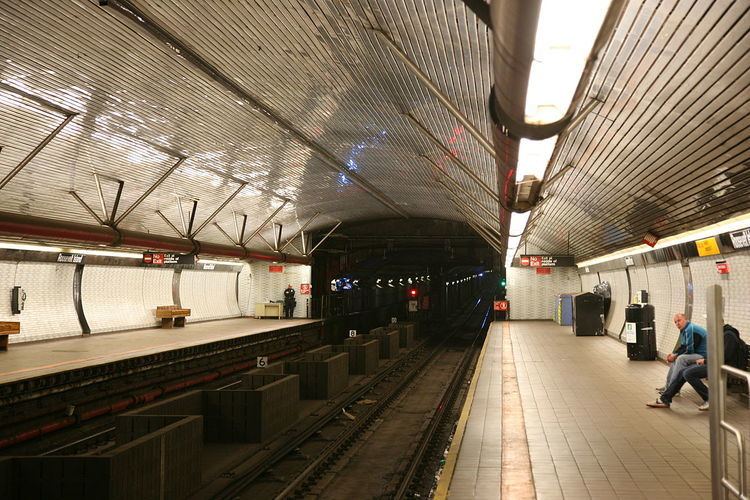Division B (IND) Services F (all times) Borough Manhattan Locale Roosevelt Island | Line IND 63rd Street Line Structure Underground Opened 29 October 1989 Tracks 2 | |
 | ||
Address Main Street near Road 5
New York, NY 10044 Transit connections Roosevelt Island Tramway
MTA Bus: Q102
RIOC: Red Bus, Octagon Express Similar 75th Avenue, Avenue X, 21st Street–Queensbridge, 57th Street, 47th–50th Streets–Rockefeller Center | ||
Roosevelt Island is a station on the IND 63rd Street Line of the New York City Subway. Located in Manhattan on Roosevelt Island in the East River, it is served by the F train at all times.
Contents
History
The current 63rd Street Line was the final version of proposals for a northern midtown tunnel from the IND Queens Boulevard Line to the Second and Sixth Avenue lines, which date back to the IND Second System of the 1920s and 1930s. The current plans were drawn up in the 1960s under the MTA's Program For Action. On February 16, 1965, the New York City Transit Authority announced plans to construct a subway station on the island along the 63rd Street Line, as part of the island's proposed transit-oriented development. The construction of a station was viewed to be vital for the development of the island, which was then known as Welfare Island. At that point, it was decided to have a shell built for the station, to allow for the station to open after the opening of the rest of the line, with a projected savings of $4 million compared to if the station was built as a infill station after the rest of the line opened. The projected cost of the station was $3,300,000.
This station opened on October 29, 1989 along with the entire IND 63rd Street Line. The Q train served the station on weekdays and the B train stopped there on the weekends; both services used the Sixth Avenue Line. For the first couple of months after the station opened, the JFK Express to Kennedy Airport also served the station until it was discontinued in 1990. The tunnel had gained notoriety as the "tunnel to nowhere" both during its planning and after its opening. Roosevelt Island was the second-to-last stop before 21st Street–Queensbridge, the line's northern terminus; the 21st Street station was not connected to any other subway station or line in Queens until the connection to the Queens Boulevard Line was completed and opened in 2001. Thereafter, the station began being served by the F train, which serves Roosevelt Island to this day.
At an April 14, 2008, news conference, Governor David Paterson announced that the MTA will power a substantial portion of the station using tidal energy generated by turbines located in the East River which are part of the Roosevelt Island Tidal Energy Project. This is part of a larger MTA initiative to use sustainable energy resources within the subway system.
Station layout
The station has two tracks and two side platforms. It is the fourth-deepest station in the New York City Subway at about 100 feet (30 m) below street level (approximately 10 stories deep) behind 34th Street–Hudson Yards, 190th Street, and 191st Street stations, also in Manhattan. Due to its depth, the station contains several features not common in the rest of the system. Similar to stations of the Paris Metro and Washington Metro, the Roosevelt Island station was built with a high vaulted ceiling and a mezzanine directly visible above the tracks.
The station is fully ADA-accessible, with elevators to street level. West of this station, there is a diamond crossover and two bellmouths that curve southward toward an unbuilt portion of the Second Avenue Subway. There is an emergency exit from the future LIRR's lower level at the middle of each platform.
Exit
Fare control is in a glass-enclosed headhouse building off of Main Street. The headhouse has a feature that is unusual to the subway system: it uses recordings of birds to try to scare away city pigeons, and these bird recordings play every few minutes or so. This is because of issues with pigeons entering the headhouse and leaving feathers and droppings both inside and around the building. Previous efforts, like spiked ledges, had been ineffective in curbing the pigeon population of the area immediately next to the station.
Ridership
In 2008, the station saw about 5,900 daily riders, compared to 3,000 for the Roosevelt Island Tramway. In 2015, an average of 6,197 daily riders used the station on an average weekday. This amounted to 1,966,493 total riders entering the station in 2015.
